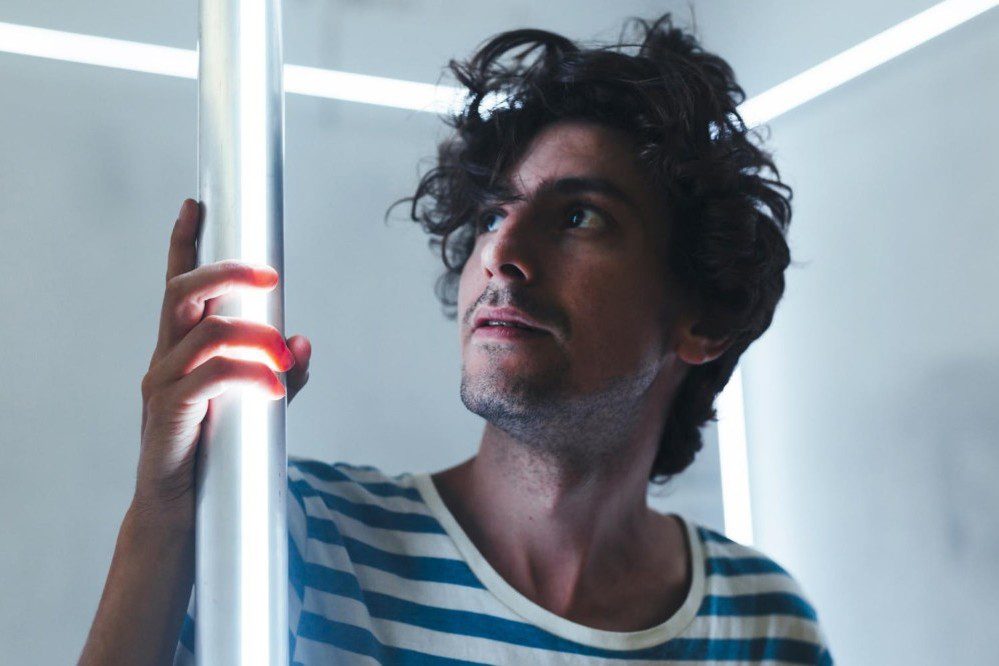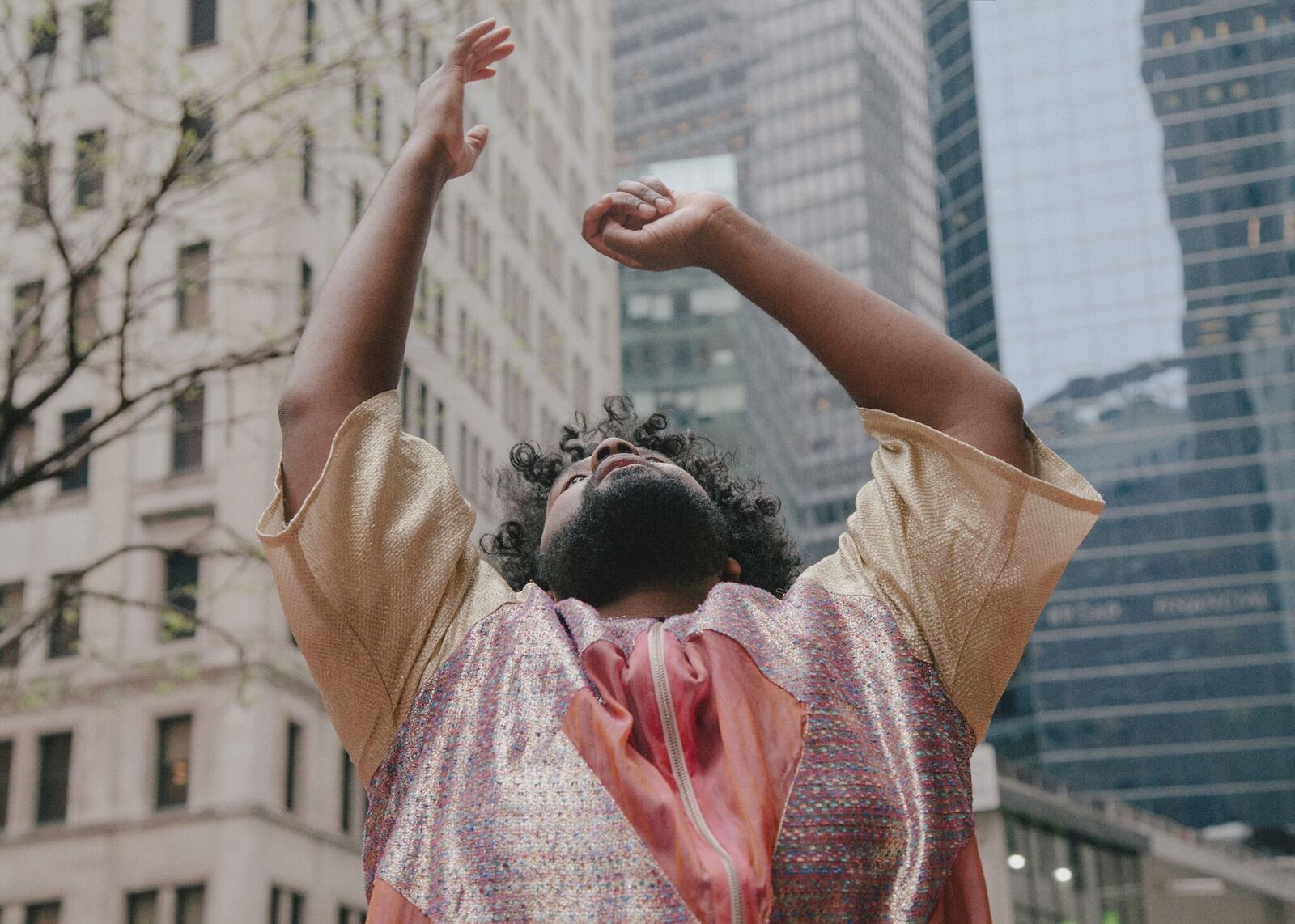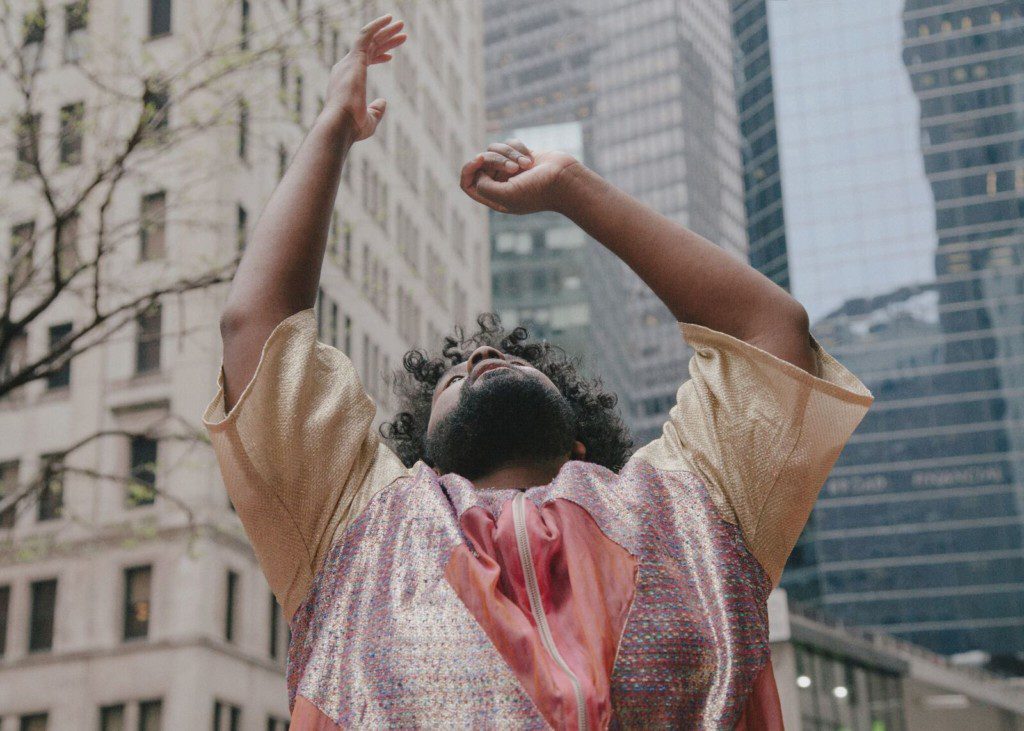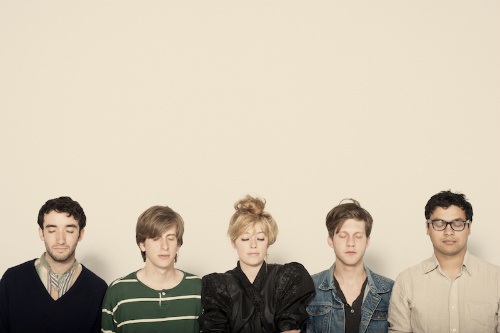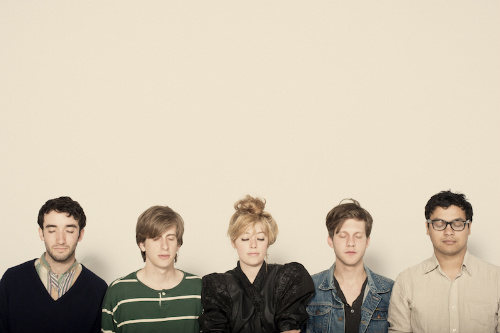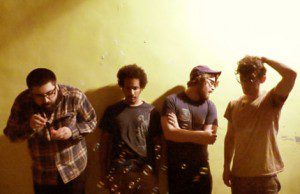1.) 2013 will be the year hip hop comes out of the closet.
As a fan of a good beat with a fondness for wordplay I adore hip-hop, but it can be really hard to reconcile that love with the homophobic and misogynistic attitudes so pervasive to the culture. It’s not that I need every rap song to be a PSA about gender equality, but is the use of the word “faggot” ever really necessary? Because I don’t care what it rhymes with – that word is ugly, especially when it’s in the middle of a verse about beating up queer people.The ironic thing is that no one does swagger better than a man dressed in drag. And when a queen stops lip-synching “It’s Raining Men” and starts emceeing, you get something like Mykki Blanco, whose dark rhymes and party-ready beats turned a Saturday night performance at the Knitting Factory into an all-out dance party. It was not the first of Blanco’s bombastic CMJ appearances, in which fabulous outfits were as standard as adept rhythm and fierce, noir-tinged rhymes – there had been a handful, including one I caught on Thursday at new party space Autumn Bowl. While the de rigeur drag show sashaying is in full effect, Blanco takes it someplace darker, appearing at Knitting Factory in black lipstick and spidery dreads, crouching low on stage and hissing into the mic as though presiding over a Satanic Black Mass. Still, danceable hits like “Wavvy” brought the audience to its seething, shimmying full potential. In those moments, it’s easy to understand what makes these artists so vital. It lies in that ability to work a room into a wicked froth and yet still full command attention.[fusion_builder_container hundred_percent=”yes” overflow=”visible”][fusion_builder_row][fusion_builder_column type=”1_1″ background_position=”left top” background_color=”” border_size=”” border_color=”” border_style=”solid” spacing=”yes” background_image=”” background_repeat=”no-repeat” padding=”” margin_top=”0px” margin_bottom=”0px” class=”” id=”” animation_type=”” animation_speed=”0.3″ animation_direction=”left” hide_on_mobile=”no” center_content=”no” min_height=”none”][jwplayer config=”AF01 YT” mediaid=”1959″]Kalif Diouf, otherwise known as Le1f, also brought killer style and mad game to the stage at the Pitchfork Topman CMJ Party, but the sound in raw new venue Villain didn’t travel as far back as you had to stand to be able to enjoy the show without a bunch of aggro Vice types getting all up in your business. Luckily, Le1f played a slew of other shows; I caught him the next evening at a late night party deep in Bushwick, closing out a bill that featured a JD Sampson DJ set. Le1f’s flow was smooth, direct, and delivered with a healthy dose of booty bounce. Over relatively minimal beats with creative textures, Le1f rhymes a mile a minute, hypnotizing audiences with heavy hip gyrations.
[jwplayer config=”AF01 YT” mediaid=”1960″]
I want to make it absolutely clear that I am not about to sing the praises of these two artists simply because they are gay and in the rap game – the talent with each is so consistent and concise that it’s a shame to have to mention sexuality at all. But, especially with hip-hop, we aren’t at a point where we can pretend that what these two (and a handful of others who didn’t happen to play CMJ showcases) are doing isn’t absolutely revolutionary, even if they are essentially just being themselves. It’s the fearless approach to the spotlight – a rightful place for either to be regardless of gender identity or sexual preference – that could change the way hip-hop regards queer artists and hopefully the LGBT population in general. If nothing else, it’s intensely satisfying to know that when I’m at a Le1f show, one of my fabulous gay homies can pick me up and spin me through the air like the queer Patrick Swayze I always dreamed would do that, and not have to worry about winding up as the victim of a hate crime afterward. Safe spaces, y’all.
2.) I’d really like to be adopted by the Woodheads of Toronto, or at least invited to a Thanksgiving dinner, but I’m not sure Canadians celebrate Thanksgiving.
Did you ever visit a friend’s house in grade school and feel like you were on another planet? Maybe because your friend had laid-back parents, or their decor was more World Market than, say, Cracker Barrel, or maybe even just because they had HBO. I don’t know what was going on in the Woodhead household but I imagine it to be a more musical, more Canadian version of The Royal Tennenbaums. I base this assumption on the fact that brothers Daniel and Airick Woodhead are two wildly talented and wonderfully weird musicians whose projects kept popping up in all sorts of CMJ venues.The brothers’ first band, Spiral Beach, was known for energetic live shows that resulted in much hype a few years ago. Though in some ways the band’s studio recordings fail to capture that energy and are musically all over the map, they established deep ties during this time within Toronto’s music scene. Maddy Wilde, the group’s female vocalist, went on to form Moon King with Daniel, a folksier, more direct offshoot of the ideas that the Spiral Beach had begun to explore. Daniel is also a frequent co-conspirator in Airick’s electro-psychedelic pop outfit Doldrums, and Airick’s been involved with AudioFemme favorites Phédre.I saw two Doldrums performances, and as the week progressed so did their confidence. The thing is, these kids are weird. They’ve got this neo-hippie stage vibe, barely stopping short of performing meditations and crystal ceremonies on stage. When they play, it’s really a head-down, focused on making odd sounds come out of keyboards and electronic gear kind of affair, though by the time they played the Knit on Saturday Airick was ripping off clothing and writhing around on stage. But Doldrums isn’t a straight-up electronics driven band – the guitars and drums are live, and so are the vocal loops which give Doldrums songs such trance-like power. For as focused and autistic as they can seem, the boys aren’t hiding behind laptops, and the results have positively psychedelic moments.
[jwplayer config=”AF01 YT” mediaid=”1962″]
By comparison, Moon King is a bit poppier, and the set at Cameo was even more mellow and toned down than I expected it to be given the EP’s frequently hyper moments. But they didn’t spare any sentiment or dreaminess. Maddy’s and Daniel’s vocals, scaled back from shriek to serenade, soar over ecstatic melodies and blend almost seamlessly together, no small feat considering the trademark almost-sneer of a Woodhead singing. Moon King isn’t really classifiable in terms of genre, but it recalls a lot of things ranging from folksy sing-along to call and response protest punk. But it’s not really any of that; it’s simply capable of evoking those moods.
[jwplayer config=”AF01 YT” mediaid=”1961″]
If Daniel and Airick never performed together, you might assume they were the same person, and even when they both grace the same stage it’s necessary to remind oneself that there’s not some mirror trick at play. I imagine their early lives to be a bit like a classic Parent Trap movie, the two of them playing clever tricks on outsiders. Or else I imagine them huddled in a blanket fort, making up secret languages only they knew how to speak. Growing up as Woodheads obviously stoked some creative fires within these boys. It’s no wonder that their various projects have become a nearly collaborative effort, and it’s interesting to note the particulars of each and speculate on what that must say about them as individuals.3.) Merchandise needs a drummer, very badly.
Merchandise released Children of Desire, an absolute gem of an EP, earlier this year. Carson Cox’s plaintive vocals and thoughtful lyrics complimented the band’s brand of new wave punk cum noise pop well. The EP shows remarkable growth for a band who built a solid following in Tampa’s punk and hardcore scene, but it became astonishingly clear at the shows I saw them play that it is mainly a studio project, without much of a live show to back it up. Cox’s vocals deliver, the guitar work was deft, and the bass as immediate as on the record, but in place of a live drummer was a drum machine, hollowly keeping time but not providing anything in the way of the heart that these songs really deserve.
With the conflagration of acts who rely on drum machines as their only form of live percussion, you would think that it might not result in so much of a let down. But Merchandise needs a drummer to really pull off the material on Children of Desire; playing without one simply doesn’t do them justice. And I saw several bands this week that I would consider contemporaries of Merchandise, all of whom delivered with blistering performances.
Savages, for instance, absolutely blew me away and were possibly one of the best bands I saw all week. Hailing from London, the all-female four piece astounded an entire room with a set that nearly bordered on sonic violence. All these ladies know how to handle their instruments; they’ve built a reputation around playing out rather than focusing on recording their material. Lead singer Jehnny Beth seethes on stage, her eyeballs wide, her gestures imploring and dramatic. The kind of energy they create is contagious, driving fans into fits, but it couldn’t be pulled off without a drummer.
Metz also brought that kind of intensity to several performances throughout the week, playing loud and fast and heavy, creating the kind of punk rock paroxysm that edges them out over other purveyors of such. But these aren’t just songs that are thrown together – they’re smartly crafted and seriously executed, never sloppy. And it’s not just about assaulting eardrums and working audiences into frenzied thrashing, because you could just as easily dance to many of the songs, as long as you weren’t in an audience full of folks hellbent on moshing (sometimes, that happens, as evidenced by the ultra-shaky video I risked life and limb to shoot at Pitchfork’s CMJ party, hosted by new party space Villain).
[jwplayer config=”AF01 YT” mediaid=”1963″]
Gap Dream scale things back just a touch, but also illustrate how fun it can be just to see a full band play and play well together. They’re from Cleveland (my hometown) and kind of have a sleazy seventies throw-back thing going on. But they had everyone dancing at their Big Snow performance. Lots of vocal reverb, elastic guitars, and pummeling drums could have filled a much bigger room than the tiny space into which we were all pleasantly crammed.
[jwplayer config=”AF01 YT” mediaid=”1964″]
These bands definitely have different things going on, but Merchandise could stand to learn a lesson from any of them. If you want to get audiences engaged, start dance (or thrash) parties, move people beyond standing with crossed arms, you need percussive power to back up even the best material. Here’s hoping their next shows will feature someone behind an actual kit.
4.) Brooklyn’s new party spaces keep the live music scene vital.
Aaaaah, Brooklyn. Years ago, CMJ was a thing that happened mainly on the Lower East Side, but each year more and more performers cross the bridge to play this lovely borough. Though I’ve been disappointed by closures of some of my favorite DIY venues, from Monster Island to Silent Barn, the scene is constantly evolving and new locales keep opening up to replace the others.I was really impressed with
Autumn Bowl, formerly a skate park (though maybe it still is?). The circular stage was smack dab in the middle of the cavernous space, and risers lined the walls, making it easy for plenty of show-goers to catch the action. It sounded great and as collaborator with Nuit Blanche New York hosted some incredible light installations. Security is around, but pretty chill. I’m hoping they’ll be hosting a lot of parties in the near future, and if they Four Tet DJ set they’ve got scheduled in a few weeks is any indication, there will be a lot to look forward to from this venue.I was slightly less impressed with
Villian, though it was mainly the sound that got to me. There are two large space separated by a wall, which makes capacity for shows smaller than what it should be but also helps keep crowding down to a minimum. Villain is operated by a marketing firm, so the events they host there definitely have the earmarks of being a bit commercial. The Pitchfork showcase I attended there was sponsored by Topman and Svedka, for instance. This isn’t necessarily a bad thing – I can’t complain about free drinks. But the bottom line is that it turns shows into sales pitches for other things, and that’s one of the elements that makes huge festivals like SXSW something of a drag. I’d hate to see the same thing happen to CMJ, which for whatever reason has escaped this fate til now.
I also got a chance to check out Big Snow Buffalo Lounge, a Bushwick rehearsal and performance space that opened just a few months shy of a year ago. The performance area is cozy to say the least, and you’re right on top of the bands as they play since there’s not an actual stage, which makes it hard to see if you’re in the back and slightly awkward if you’re up front. But that’s not to say the venue doesn’t have its charms, and the sound is unimpeachable and really, really loud.
I was super excited to check out Delinquency, especially since they’d booked a bunch of awesome shows and dance parties and were said to inhabit five or more separate rooms of an old warehouse. Unfortunately, the venue was lacking the permits it needed, proving that operating a space in NYC isn’t the least complicated thing in the world, and rescheduled all its events at other venues.
The thing is, the venues I’ve here mentioned don’t even begin to scrape the surface of all that Brooklyn has to offer in terms of raw DIY spaces, and in the course of researching for our showcase (see below!) I found out that there are so many that I’ve yet to hear of. Once resource I’m absolutely grateful for in sorting all of that out is Brooklyn Spaces, a compendium as complete as any I’ve seen of art collectives, galleries, performance spaces, studios, nonprofits, party places, and underground theaters. Attending these venues is paramount to keep Brooklyn’s thriving underground and DIY scene going, so we encourage you to check them out and support them when you can.
5.) Putting together a showcase is hard.
Okay, so maybe this should have been more obvious to me to begin with, but we AudioFemmes barely had an inkling of what we were getting ourselves into when we started booking our blog’s showcase. There are spaces to contact, sponsors to reach out to, and then there are the bands. We’d have loved to host handfuls of them – picking bands out was certainly not the problem. But tracking them down, or tracking down their management, or the label, or whoever, was just the first difficult step in actually confirming anyone to play. Even if it hadn’t come together, we had quite the learning experience, but we’re happy to report that we put together a lovely little shindig featuring Datalog, Which Magic, Foxes In Fiction, and Autodrone. The fact that it was on a Tuesday afternoon mattered little, we pulled it off for those that showed up, and recorded each brilliant performance (look for a stream of the audio from the show soon!).
